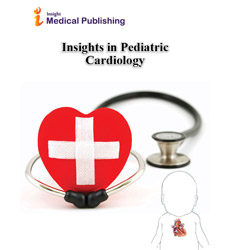A Case Series Outlining the Relationship Between Dolichoectasia and Ectrodactyly - Ectodermal Dysplasia - Clefting Syndrome
Cameron John Sabet
Cameron John Sabet*
Department of Pharmacology, University of Pennsylvania
- *Corresponding Author:
- Cameron John Sabet
Department of Pharmacology, University of Pennsylvania
Tel:7035590421
E-mail: camstar1863@gmail.com
Received Date: July 30, 2021; Accepted Date: October 11,2021; Published Date: October 21, 2021
Citation: Cameron J S, A Case Series Outlining the Relationship between Dolichoectasia and Ectrodactyly-Ectodermal Dysplasia-Clefting Syndrome, Insights Pediatr Cardiol: Vol: 5.Issue No:5
Abstract
Ectrodactyly-Ectodermal Dysplasia-Clefting Syndrome (EEC) is a rare heritable condition marked by ectodermal dysplasia with nails, teeth, sweat glands, and hair, eye and lacrimal duct malformations, midfacial hypoplasia, ectrodactyly (loss of fingers or toes), syndactyly, clinodactyly, auricular anomalies, short height, orofacial cleft palates, genitourinary anomalies, malformations within the central nervous system (CNS) leading to mental impairment or hearing loss, nevocellular nevi, flat noses, and hypopigmentation (National Foundation for Ectodermal Dysplasias 2021 and Cyriac & Lashpa 1980).
Introduction
The connection between dolichoectasia and EEC has not yet been outlined in a formal literature review or even case series, so this article aims to explore a series of case reports to better highlight the various etiologies, symptoms, and presentations of EEC as they relate to dolichoectasia. The dilation and elongation of arteries in the cranial cavity is called cerebral arterial dolichoectasia. To date, the correlation between dolichoectasia and EEC has not been studied thoroughly, though one case report specifically mentioned the possibility of those two conditions being frequently paired without delving into the literature to verify this claim. EEC, specifically lobster claw, occurs both in a familial inheritance pattern as well as sporadically. One of the earliest articles suggesting a correlation between dolichoectasia and EEC was a paper describing a 44- year-old black female who was born with bilateral lobster claw deformities on her feet, but no other structural abnormalities. Her two siblings had experienced seizures, but no structural abnormalities. This 44-year-old had very little body hair and presented with decayed teeth. For four years before her diagnosis, she had been treated for chronic renal failure and hypertension, as well as having had congestive heart failure many times, each time requiring her admittance to the hospital. At birth, the patient presented with lobster claw deformities of both feet but no other congenital abnormalities. She later developed lancinating pain in her right mandible that was sensitive to movement—chewing or talking mainly [1-6].
Conclusion
Eventually, this pain grew to the point that she could not eat or speak at all. Vertebrobasilar angiograms revealed dilation, elongation, and displacement of the basilar artery (Miner 1980). All of the case reports describing EEC patients, even the ones from before angiograms were incorporated into the diagnostic checklist for clinicians, agree on some form of mental divergence of the patients afflicted with EEC. For example, one report mentioned “moderate psychomotor” dysfunction, another patient was reported to be placed in an institution for mentally divergent people, another presented with peripheral facial nerve palsy, while yet another case presented with an 81 IQ score
The presentation of EEC in relation to dolichoectasia is extremely rare not only due to the fact that each separate condition is already rare, but that EEC is usually attributed to some familial or sporadic inheritance while dolichoectasia usually develops in the presence of long-standing hypertension .
We hope that this article better outlines the current literature surounding the relationship between EEC and doliochoestasia, as well as highlights the lack of understanding arising from the absence of angiograms performed before 1970 on EEC patients due to the fact that the technology had not been developed yet.
References
- Miner, M.E., Rea, G.L., Handel, S. et al. Trigeminal neuralgia due to dolichoectasia: Angiographic and CT findings in a patient with the EEC syndrome. Neuroradiology 20, 163–166 (1980).
- Cockayne EA. Cleft palate-lip, hare lip, dacryocystitis, and cleft hand and foot. Biometrika 1936;28:60–63.
- Berndorfer, A.: Gesichtsspalten Gemeinsam Mit hand und Fuß Spalten, Z. Orthop. 107: 344, 1969.
- Smoker WR, Corbett JJ, Gentry LR, Keyes WD, Price MJ, McKusker S. High-resolution computed tomography of the basilar artery: 2. Vertebrobasilar dolichoectasia: clinical-pathologic correlation and review. AJNR Am J Neuroradiol. 1986 Jan-Feb;7(1):61-72. PMID: 3082145.
- Cyriac, M J, and E. Lashpa. “ Lobster-Claw Hand: A Manifestation of EEC Syndrome.” Indian J Dermatol Venereol Leprol, 2006,
- Ectrodactyly-Ectodermal Dysplasia-Clefting Syndrome. National Foundation for Ectodermal Dysplasias. (2021, June 4).
Open Access Journals
- Aquaculture & Veterinary Science
- Chemistry & Chemical Sciences
- Clinical Sciences
- Engineering
- General Science
- Genetics & Molecular Biology
- Health Care & Nursing
- Immunology & Microbiology
- Materials Science
- Mathematics & Physics
- Medical Sciences
- Neurology & Psychiatry
- Oncology & Cancer Science
- Pharmaceutical Sciences
